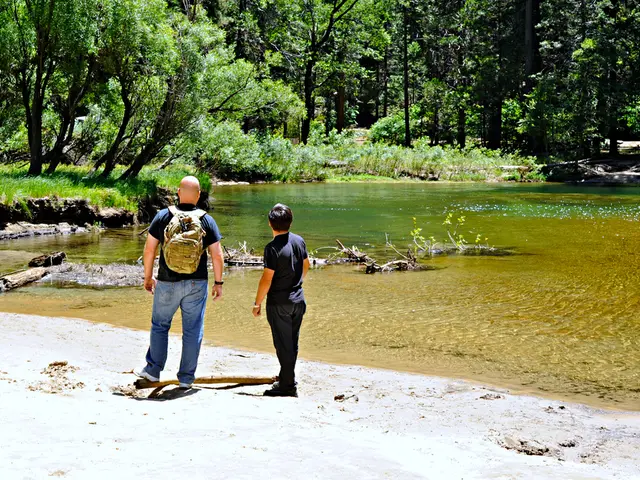Keep an eye out for these minuscule menaces contributing to the disease spread in the DMV region
In the Mid-Atlantic region, there has been a significant increase in cases of Babesiosis, a tick-borne infection that can lead to serious complications such as jaundice and hospitalizations. The disease, caused by a parasite transmitted by ticks, often presents flu-like symptoms, including fever, chills, headache, body aches, and fatigue. In severe cases, dark urine and jaundice may occur.
To reduce the risk of Babesiosis, a multi-layered approach is recommended.
1. **Avoid Tick Habitats**: Stay out of wooded, bushy, or tall grassy areas where ticks are common. Stick to the center of trails when hiking to avoid tick-infested vegetation. Avoid leaf litter and dense underbrush.
2. **Protective Clothing**: Wear long-sleeved shirts and long pants. Tuck pant legs into socks or boots to prevent ticks from crawling inside clothing. Wear light-colored clothing to make ticks easier to spot.
3. **Use of Repellents**: Apply EPA-registered insect repellents containing DEET, picaridin, IR3535, or oil of lemon eucalyptus on exposed skin. Treat clothing and gear with permethrin (a synthetic insecticide and repellent) which remains effective through several washes.
4. **Landscape Management**: Keep lawns mowed short. Clear leaf litter and debris from yards. Create 3-foot-wide barriers of wood chips or gravel between lawns and wooded areas to block tick migration. Fence yards to keep out deer, a common tick host. Trim overgrown vegetation to reduce tick-friendly environments.
5. **Post-Outdoor Activity Checks**: Conduct full-body tick checks immediately after outdoor activities. Examine pets and gear that may carry ticks indoors. Shower within two hours of returning indoors. Dry clothes on high heat for 10 minutes to kill any ticks.
When a tick is found, use fine-tipped tweezers or a specialized tick removal tool to grasp the tick close to the skin. Pull upward with steady, even pressure without twisting or jerking. Clean the bite area and hands thoroughly after removal. Save the tick in a sealed container for identification and testing if symptoms develop.
Besides DEET and picaridin, oil of lemon eucalyptus is a plant-based alternative shown to be effective. Using permethrin-treated clothing is highly recommended for sustained protection. Avoid folk remedies like nail polish, petroleum jelly, or heat on attached ticks, as these can increase disease transmission risk.
The U.S. Army's MilTICK program allows Department of Defense personnel and their beneficiaries to submit ticks for identification and disease screening. Early removal and identification of ticks are critical to reduce the risk of disease.
The black-legged tick, also known as Ixodes Scapularis or deer tick, is responsible for the spread of Babesiosis. Tick season is currently ongoing in D.C., Maryland, and Virginia. The spread of the black-legged tick has been increasing in the mid-Atlantic, Virginia, and Maryland.
A new study published in the Journal of Medical Entomology reports this increase in the spread of the black-legged tick. The tick can survive in temperatures above 40 degrees and thrive in high humidity. It's essential to be vigilant and take the necessary precautions to protect yourself and your loved ones from Babesiosis.
- Embracing workplace-wellness programs can help manage chronic diseases like Babesiosis, which is seeing an uptick in the Mid-Atlantic region.
- Science plays a crucial role in understanding and combating the spread of Babesiosis, as well as other medical-conditions that threaten public health.
- Respiratory-conditions, such as asthma, can be worsened by environmental factors, including weather changes related to climate-change.
- Mental-health issues are increasingly prevalent in today's fast-paced lifestyle, where many individuals struggle to maintain balance amidst work, relationships, and personal responsibilities.
- Skin-care is essential for overall health and wellness, particularly during the warm months when UV exposure increases.
- Fitness-and-exercise is a crucial component of any health-and-wellness regimen, aiding in the prevention of various chronic diseases like diabetes and cardiovascular diseases.
- Nutrition is key in maintaining a balanced lifestyle, with food-and-drink choices playing a significant role in overall health.
- Neurological-disorders and brain function can be influenced by environmental-science factors such as exposure to environmental toxins and pollution.
- Cybersecurity is essential in today's digital age, with an increasing number of threats to personal and corporate data.
- As we become more connected, our relationships and interactions with people, pets, and even technology are becoming increasingly important.
- Traveling opens us up to new experiences and cultures but can also expose us to different diseases, such as Babesiosis, Malaria, and Zika.
- Sports participation isn't just about fun and fitness – it's a vital part of maintaining overall health and wellness, while simultaneously fostering a sense of community and camaraderie.




